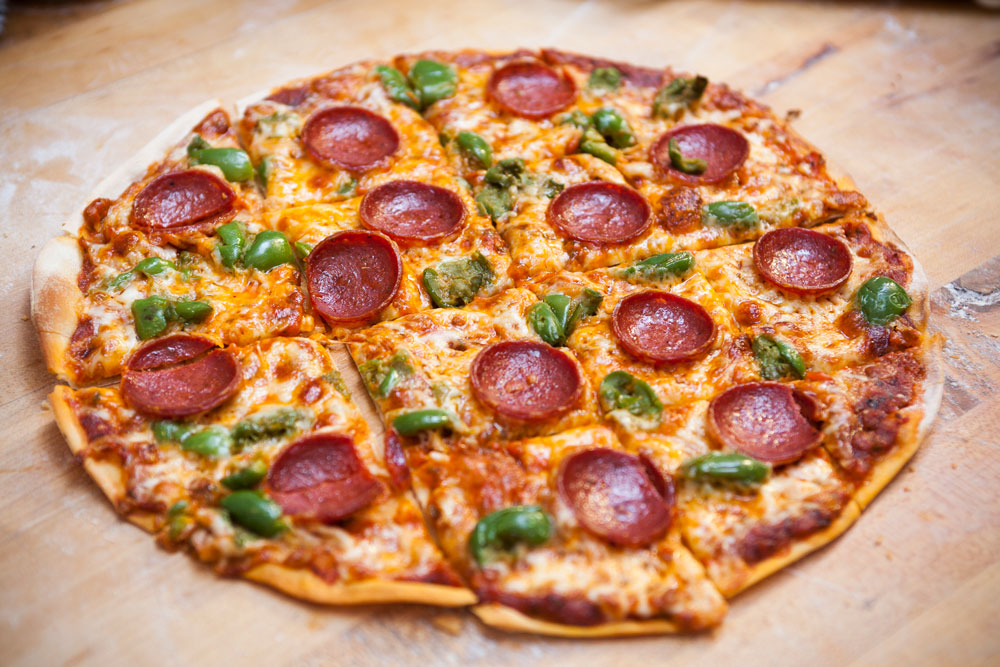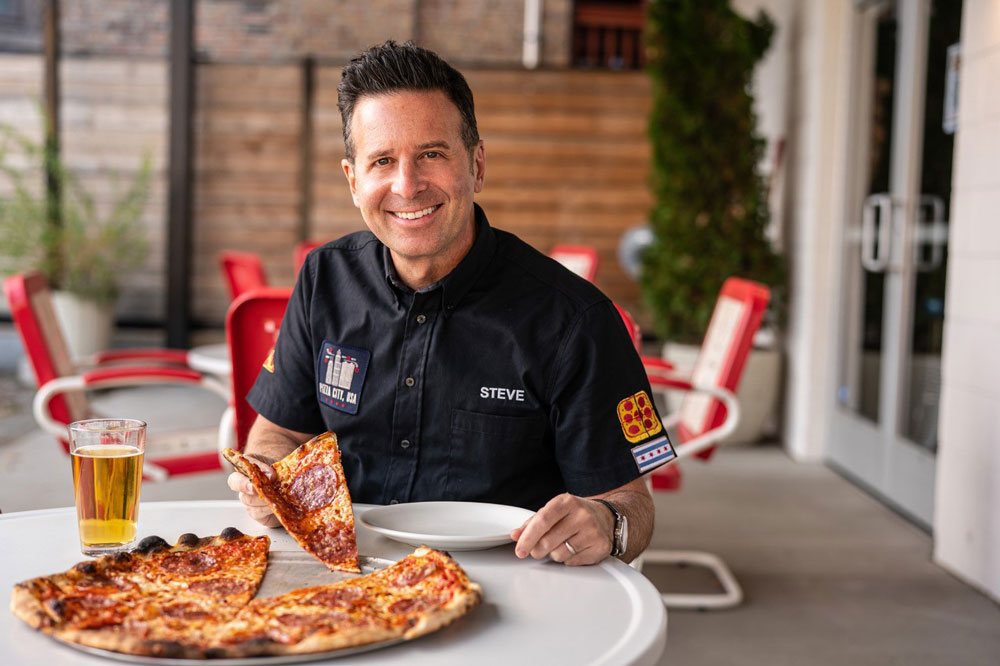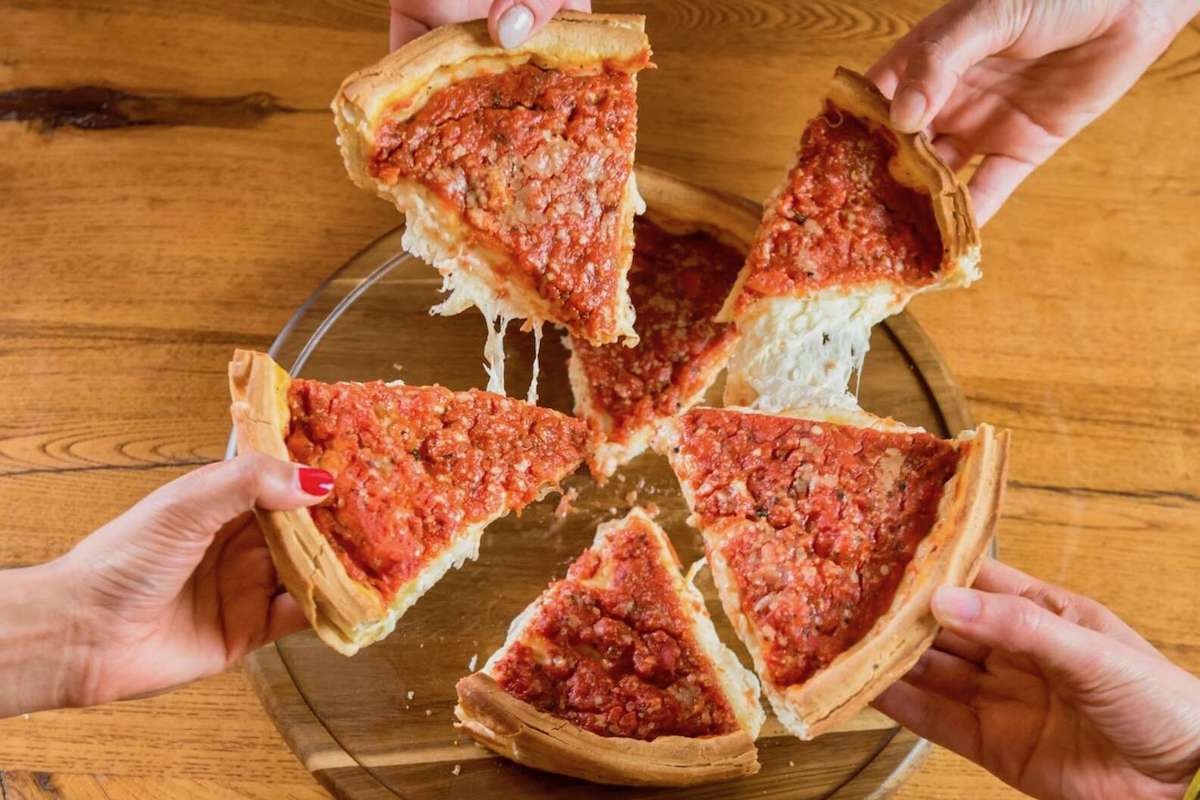- Not one, not two, but three distinctive styles of pizza originated in Chicago, giving it a legit claim to being the best pizza city in the U.S.
- “It would be crazy if, every time we wanted to eat pizza, it was a deep-dish,” says Jonathan Porter of Chicago Pizza Tours.
Related: Q&A with Jonathan Porter: Chicago-style pizza and where to eat it
By Rick Hynum
Carl Sandburg famously summed up the Windy City in a poem titled “Chicago.” He wrote about the tool makers, the hog butchers, the freight handlers, even the mobsters and the “painted women under the gas lamps luring the farm boys.” But he never said a word about the pizza makers. Then again, Sandburg wrote the poem in 1914, and pizza wasn’t a thing there yet. Today, it’s one of the city’s defining traits—and we’re talking not one, not two, but three distinctive styles of pizza that originated there. No other U.S city can lay claim to that kind of diversity. And there are some two-fisted Chicagoans who might slug you if you told them otherwise.
But Chicago’s pizza scene is still widely misunderstood. Yes, there’s the deep-dish style, and that’s an experience unto itself. Not everyone loves it—comedian Jon Stewart once jokingly called it “an above-ground marinara swimming pool for rats”—and locals, frankly, don’t eat a lot of it. Yet when many non-Chicagoans think pizza, they think deep-dish and only deep-dish.

Jonathan Porter of Chicago Pizza Tours visits with Robert Garvey, owner of Robert’s Pizza and Dough Company.
Jonathan Porter, owner of Chicago Pizza Tours, gets a lot of that. Founded in 2009, his company has 10-plus employees and operates several buses that take tourists to iconic pizzerias and off-the-beaten-path joints all over the city. “For out-of-towners, there’s that shocked look on their face when I say, ‘Now, Chicago is known as the deep-dish capital of the world, but, for the most part, the locals only eat it on special occasions or when people from out of town are visiting us. What we grew up on is a thin-crust tavern-style pizza, a circular pizza cut into squares,’” Porter says. “Luckily, we usually have some locals on every tour who start nodding in agreement to help back me up.”
Porter’s clients still go back to their hotels happy. “Those out-of-towners are usually relieved by the end of the tour that it wasn’t all deep-dish, since we typically sample around eight slices,” he says. “It also gives them a real sense of what the pizza culture is truly like in Chicago. It would be crazy if, every time we wanted to eat pizza, it was a deep-dish.”
“The lore behind who invented [deep-dish pizza] makes for a great story, and it adds to the mystique of the style. But, in the end, it doesn’t really matter who, how, when or why it happened. All we know for 100% certain is where.”
— Jonathan Porter, Chicago Pizza Tours

Tavern-style thin-crust pizza is the style that most Chicagoans eat on a regular basis, while deep-dish is reserved for special occasions.
Think Deeper
After all, the deep-dish variety, made famous by chains like Pizzeria Uno, Lou Malnati’s and Gino’s East, is hardly light, lunchtime fare. Baked in round steel pans, a deep-dish pie can range from between 1” and 3” thick, with the ingredients layered on in reverse order: The cheese goes first, then the meats, next the veggies, and finally a generous quantity of crushed tomatoes. The crust itself might be thin to medium, but it feels thicker because it’s loaded with ingredients. Put plainly, it’s a belly-buster.
The origin of deep-dish pizza is shrouded in controversy, although not for lack of self-proclaimed inventors. It debuted at Pizzeria Uno in 1943 under founder Ike Sewell, who also started Pizzeria Due in 1955. “The lore behind who invented it makes for a great story, and it adds to the mystique of the style,” Porter says. “But, in the end, it doesn’t really matter who, how, when or why it happened. All we know for 100% certain is where. The story I heard growing up is that Ike Sewell, a Texan, came to Chicago with a dough recipe and thought that pizza needed to be bigger and better—the Texas way! But that story has long been debunked, and it turns out that Ike was more of an opportunist after [other] people passed and the pizza became a hit.”
The National Pizza and Pasta Show: Go deep and grow in Chicago!

Steve Dolinsky, author of The Ultimate Chicago Pizza Guide
Ric Riccardo (born Richard Novaretti) was Sewell’s business partner, and the two originally planned to open a Mexican restaurant. But, the story goes, Riccardo got sick from some Mexican food and proposed a pizza joint instead. Did Riccardo invent deep-dish pizza? “That story likely checks out,” Porter says. “He purchased the [Pizzeria Uno] building, lived upstairs and was quite the chef himself. The part I get stuck on is, we really don’t know if the pizzas he first created were even deep-dish.”
And let’s not forget Rudy Malnati Sr., who worked at Pizzeria Uno and whose wife, Donna Marie, was a “dough maker extraordinaire,” according to the Chicago Sun-Times. Their son, Lou, went on to found Lou Malnati’s, while Rudy Jr. founded Pizano’s. The Malnatis were “integral to the success” of Pizzeria Uno, Porter notes, and there are “several pictures of Lou serving the deep-dish pizza to his father. But, again, no one knows for sure.”

Lou Malnati (right) serves a deep-dish pie to his dad, Rudy Malnati Sr. Both men helped to popularize deep-dish pizza. Photo courtesy Pizzeria Uno.
The true story behind deep-dish pizza might ultimately be “anticlimactic,” Porter says. And there were probably some unsung heroes involved. “We think that, most likely, over time, as pans broke and they couldn’t source them again, the pans got bigger. And as those pans got bigger, the recipe was adjusted to make sure everything worked. The kitchen was largely African-American women from the South, and we do know they played an integral part in the deep-dish pizza’s success. Whether someone invented it, popularized it or altered it, it’s all tough to say. But that’s what makes the lore of the deep-dish pizza so cool!”
The Hidden Gems
We asked Jonathan Porter of Chicago Pizza Tours to share some of his favorite lesser-known pizza spots in the Windy City:
“For me, hidden gems are the places that aren’t near the downtown areas. There really are some great places close to downtown, like Pizano’s, Robert’s and Flo & Santo’s, but it would be tough to classify them as off the beaten path. I love hanging in Chicago’s 70-plus neighborhoods. If you’re going to a Cubs game up north, try Coalfire, Spacca Napoli or Bartoli’s. Find yourself in Bucktown or Logan Square, and I love Paulie Gee’s, Piece, My Pi and Pizza Friendly Pizza, or head to John’s on Western Avenue for some tavern-style. Going to a White Sox game? Stop off before the game at Phil’s on 35th for tavern-style or Pizza Fried Chicken Ice Cream on 31st. Did you fly into Chicago via Midway? Don’t miss Vito & Nick’s! This list could go on way too long.”
Think Thinner
So deep-dish is bigger, thicker and more mysterious. For some, that’s what you call sex appeal. But if you want to eat like a Chicagoan, thinner is the winner. Break away from the tourist destinations, and you’ll find a lot of tavern-style pizza. Tavern-style, Porter says, “is what I grew up on. It makes up the majority of the pizza in Chicago, and it is no doubt the pizza that Chicagoans do best.”
“Chicago is definitely a city of neighborhoods, much like how New York has its different boroughs and different generalizations with each one,” says Derrick Tung, the Chicago-born owner of Paulie Gee’s Logan Square. “From a pizza perspective, the South Side is really more known for its thinner and tavern-style crusts, but that doesn’t necessarily mean the North Side is just deep-dish and stuffed crusts.”
Related: How various flours created the world’s best-known pizza styles

A server at Nancy’s Pizzeria gets ready to wow a guest with a slice of stuffed pizza. Photo courtesy Nancy’s Pizzeria.
In his book, The Ultimate Chicago Pizza Guide, journalist and food writer Steve Dolinsky writes, “Ask die-hard Chicagoans how they define ‘Chicago pizza,’ and they’ll respond with a unanimous ‘thin’ rather than thick.’” Dolinsky, who provides his own pizza tours of Chicago through his company, Pizza City USA, believes the media and heavy marketing from the deep-dish chains have created the impression that Chicago is strictly a deep-dish town. “But no amount of advertising or tourism hype can change the fact that most Chicagoans like their pizza thin.”
Tavern-style pizza boasts a cracker-thin crust that’s sliced into crispy squares—ideal for sharing—and often loaded with fennel sausage and maybe some pickled giardiniera, too. The style was created for hard-working immigrants as a cheap snack and a good pairing with drinking sessions after a shift. Vito & Nick’s was arguably the first to offer the style, with other South Side joints like Home Run Inn and Italian Fiesta Pizzeria jumping on board with their versions later.
In addition to the above-mentioned stalwarts, Dolinsky’s book spotlights a number of Chicago’s must-try tavern-style hot spots, including Flo & Santos, Geo’s Pizza, Pat’s Pizzeria and Salerno’s Pizza of Chicago.

To many, the Giordano’s brand is synonymous with Chicago-style pizza. Photo courtesy Giordano’s.
Think Stuffier
Finally, there’s a brash younger upstart: stuffed-crust pizza. In The Ultimate Chicago Pizza Guide, Dolinsky notes that this Chicago-born variety “consists of two distinct doughs: one on the bottom that is connected to a circular wall of dough lining the deep pan…[and] the other, a thinner ‘top crust’ dough that rests over the cheese and ingredients, punctured with a few vent holes, then topped with an even amount of tomato sauce.”
At the Giordano’s chain, with 70 stores in nine states, stuffed pizza has dominated the menu since founding brothers Joseph and Efren Boglio opened their first location in 1974. When many Americans think of stuffed-crust pizza, they think of Giordano’s. But according to Dolinsky, the style, inspired by an Italian Easter pie called scarciedda, was actually introduced in 1971 by Italian immigrant Rocco Palese, who co-owned Guy’s Pizza with his wife, Nancy. They went on to open the first Nancy’s Pizzeria, which was lauded for serving “The Best Pizza in Chicago” by Chicago magazine in 1975.
Shortly before that, the Boglio brothers, who had worked for the Paleses at Nancy’s, opened Giordano’s on the South Side. Both restaurant companies have earned legendary status since their fledgling days, although Giordano’s opened more locations faster early on. But Nancy’s today is no slouch, either, with 28 locations in four states. When Nancy Palese died on January 20, 2022, the Chicago Tribune said her name was “synonymous with stuffed pizza in Chicago.” Still, Nancy’s and Giordano’s have challengers galore. From Suparossa and Doreen’s to Angelo’s Stuffed Pizza, there’s no shortage of Windy City restaurants with the right stuff.
“The South Side is really more known for its thinner and tavern-style crusts, but that doesn’t necessarily mean the North Side is just deep-dish and stuffed crusts.”
— Derrick Tung, Paulie Gee’s Logan Square
All Things to All Pizza People
So one city, three original pizza styles and loads of controversy. But Chicago is all things to all pizza fans. Name any style—New York, Neapolitan, Detroit—and the city’s got it now. “Chicago, like many other cities, has had a renaissance in pizza, with multiple styles taking over throughout the city and surrounding areas,” Tung says.
At Paulie Gee’s Logan Square, for example, Tung serves both Neapolitan and Detroit styles alongside New York slices. Before he went into the pizza business, Tung, who grew up on tavern-style and deep-dish, fell in love with wood-fired Neapolitan pies at Pizzeria Neo, a now-closed eatery in nearby Naperville. “I became obsessed with learning more about this particular style, which eventually led me to meeting Paulie Gee and deciding to work together to open in Chicago,” he recounts. In the meantime, Tung and his wife went on a cross-country journey and tried numerous acclaimed pizza shops along the way. In a visit to Buddy’s Pizza in Detroit, Tung fell in love again. “The texture of crisp to airy/light, the flavors…it was so good that, much like the Neapolitan experience, I had to learn how to make my own,” he says.
Related: Derrick Tung: Paying your pizzeria’s employees well can yield big dividends

Derrick Tung of Paulie Gee’s Logan Square
Tung embodies the egalitarian spirit of Chicago’s pizza scene. He has known a few New York pizza snobs and doesn’t think Chicagoans are nearly as elitist in that regard. With so many styles available in their city, they know all pizza, made right, is good pizza. “I may make a whole city mad, but New York is not the only mecca for pizza anymore, especially depending on the styles you’re looking for,” Tung says. “Social media and food media have created the ability to see what one pizza maker is doing on a worldwide basis almost instantaneously, and the community of pizza makers often are happy to share knowledge and techniques with each other. The growth of pizza quality and styles is at an unprecedented time. From what I see coming out of Japan and hearing about pizza in Brazil, there’s a lot of new techniques pushing the boundaries of how to continue to elevate pizza.”
For his part, Porter makes sure to give his Chicago Pizza Tours customers a taste of everything the city has to offer. “We [feature] a range of styles in different neighborhoods,” Porter says. “It is quite the tour to spend three-and-a-half hours visiting four pizzerias in four neighborhoods, trying two different deep-dishes, two different tavern-style thin-crusts and one off-the-wall style, like a coal-fired or artisanal pie. By the end of the tour, the guests really are unable to compare any of the slices because they are all so different.”
Rick Hynum is PMQ’s editor in chief.













